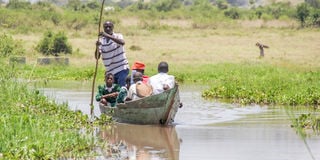How flooded village is using simple tactics to ride out storm

Pupils from Ndhuru Primary School in Lambwe, Mbita Sub-County, Homa Bay County, cross a flooded section of the area.
What you need to know:
- To date, dozens of homes in a tiny village in Karachuonyo North are still submerged.
- The floods also submerged latrines and a shopping centre.
For the past one year, Grace Onyango and tens of villagers in Chuowe Beach, Homa Bay County, have not had a permanent place to call home.
Following heavy rains in parts of the country from late 2019 to the better part of 2020, hundreds of homes, schools and farms were flooded, forcing residents to flee.
To date, dozens of homes in a tiny village in Karachuonyo North are still submerged. But besides having thrown many out of their homes, the ravaging floods which also submerged latrines and a shopping centre could have done worse by triggering a public health crisis.
Sitting just a few kilometres from Lake Victoria, Chuowe beach is a fishing village that has been courting challenges from indiscriminate sand harvesting, hippo attacks to poor sanitation yet somehow the residents have survived.
“Houses and latrines were submerged, causing a scare,” said Willis Omulo, a resident and chairman of Aluora Makare Community Based Organisation, which champions environmental issues.
With the plight of the flood victims at stake, community leaders, county government and humanitarian organisations came up with interventions to cushion them against further disasters.
Flooded toilets
Prof Richard Muga, the Homa Bay County health Chief Executive Officer said while the moves were rushed to respond to the urgent need, they managed to avoid the worst.
“The lake’s backwash flooded toilets. The county recruited community health workers to conduct regular health talks, and distribute water treatment pills among other public interventions,” said Prof Muga.
Grace, a mother of seven, said they boiled water for domestic use and community health workers in the county played a crucial role through their regular health talks.
“There were so many families sharing the school compound where we took refuge. Therefore, the county government urgently constructed additional latrines,” she said, adding that they also received water treatment tablets from the community workers.
She further added sanitisers and frequent hand-washing measures introduced as part of Covid-19 prevention measures have helped the families to deal with poor-hygiene related infections.
Emily Opiyo, a community health worker employed by the county government, said: “We have been training on proper hygiene both through communal groups and door-to-door and we encourage families to use what they have,” she says.
When they could not get water treatment tablets, they advised households to boil water instead.
“This time around, for instance, there were no mosquito nets to distribute. Therefore, we advised locals to use their old nets and sew them when they get torn,” said Emily.
Community health workers are also training the residents to construct pit latrines using plastic drums or concrete culverts to stop the pits from sinking during floods.
The biggest challenge with the new pit latrine technologies is that not many residents can afford them, she said.
Wanton sand harvesting and floods having made it difficult for electric poles to remain firm, the village was disconnected from the national grid. But the village is not in darkness since many residents are using solar lighting.



